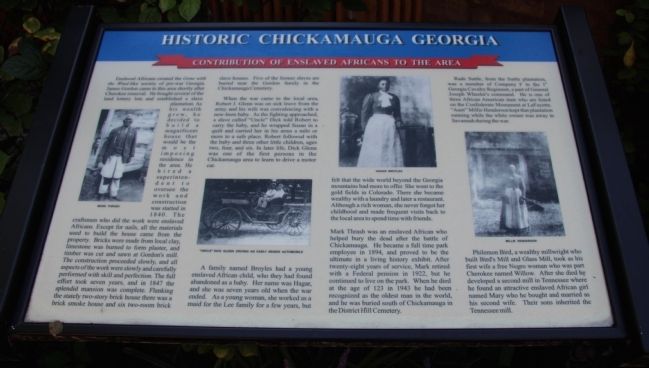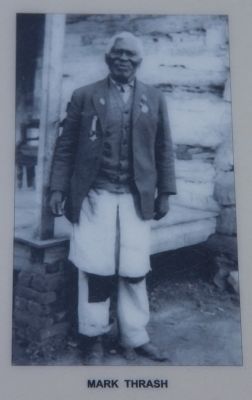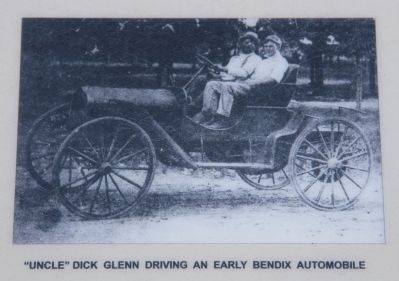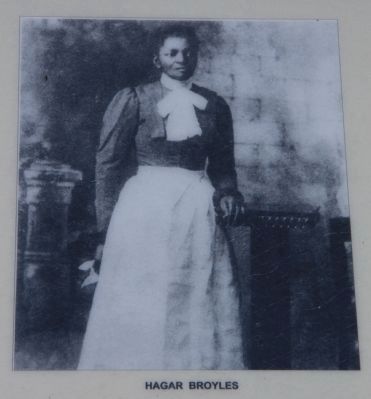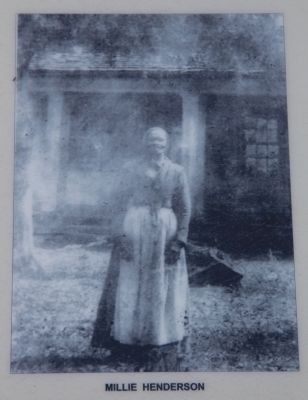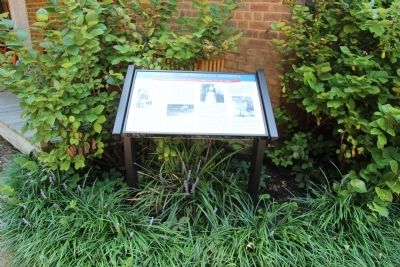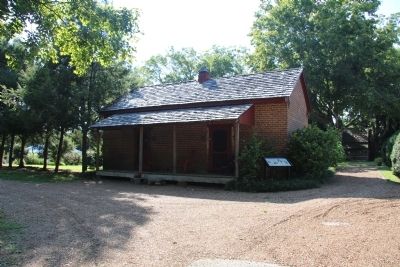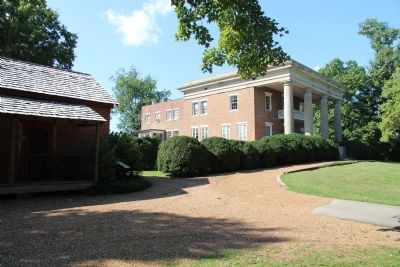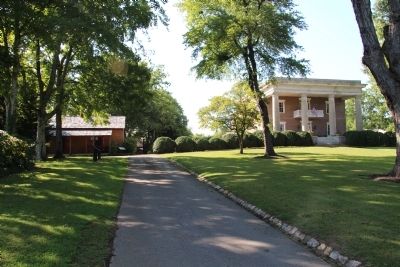Chickamauga in Walker County, Georgia — The American South (South Atlantic)
Contributions of Enslaved African to the Area
Historic Chickamauga Georgia
Inscription.
Enslaved Africans created the Gone with the Wind-like society of prewar Georgia. James Gordon came to this area shortly after Cherokee removal. He bought several of the land lottery lots and established a slave plantation. As his wealth grew, he decided to build a magnificent house that would be the most imposing residence in the area. He hired a superintendent to oversee the work and construction was started in 1840. The craftsmen who did the work were enslaved Africans. Except for nails, all the materials used to build the house came from the property. Bricks were made from local clay, limestone was burned to form plaster, and timber was cut in sawmill at Gordon's Mill. The construction proceeded slowly, and all aspects were closely and carefully performed with skill and perfection. The full effort took seven years, and in 1847 the splendid mansion was complete. Flanking the stately two-story brick house there was a brick smokehouse and six two room brick slave houses. Five of the former slaves are buried near the Gordon family in the Chickamauga Cemetery.
When the war came to the local area, Robert J. Lynn was on sick leave from the army and his wife was convalescing with a newborn baby. As the fighting approach, a slave called “Uncle” Dick told Robert to carry the baby, and he wrapped Susan in a quilt and carried her in his arms a mile or more to a safe place. Robert followed with a baby and three other little children, ages two, four, and six. In later life, Dick Glenn was one of the first persons in the Chickamauga area to learn to drive a motor car.
A family named Broyles had a young enslaved African child, who they had found abandoned as a baby. Her name was Hagar, and she was seven years old when the war ended. As a young woman, she worked as a maid for the Lee family for a few years, but felt that the wide world beyond the Georgia Mountains had more to offer. She went to the gold fields in Colorado. There she became wealthy with a laundry and later a restaurant. Although a rich woman, she never forgot her childhood and made frequent visits back to the local area to spend time with friends.
Mark Thrash was an enslaved African who helped bury the dead after the battle of Chickamauga. He became a full-time park employee in 1894, and proved to be the ultimate in a living history exhibit. After twenty-eight years of service, Mark retired with a federal pension in 1922, but he continued to live on the park. When he died at the age of 123 in 1943 he had been recognized as the oldest man in the world, and he was buried south of Chickamauga in the District Hills Cemetery.
Rude Suttle, from the Suttle plantation, was a member of Company F in the 1st Georgia Calvary
Regiment, a part of General Joseph Wheeler's command. He is one of three African American men who are listed on the Confederate Monument at Lafayette. “Aunt” Millie Anderson kept that plantation running while the white owner was away in Savannah during the war.
Philemon Bird, a wealthy millwright who built Bird's Mill and Glass Mill, took as his first wife a free Negro woman who was part Cherokee named Willow. After she died he developed a second Mill in Tennessee where he found an attractive enslaved African girl named Mary who he bought and married as his second wife. Their sons inherited the Tennessee Mill.
Erected by Historic Chickamauga.
Topics. This historical marker is listed in these topic lists: African Americans • Settlements & Settlers • War, US Civil. A significant historical year for this entry is 1840.
Location. 34° 52.293′ N, 85° 17.689′ W. Marker is in Chickamauga, Georgia, in Walker County. Marker can be reached from Cove Road (Georgia Route 341) south of Gordon Street. This marker is located on the grounds of Gordon Lee Mansion Park, at the back end a driveway that goes back into the property, at the northeast corner of the slave cabin. Touch for map. Marker is at or near this postal address: 217 Cove Road, Chickamauga GA 30707, United States of America. Touch for directions.
Other nearby markers. At least 8 other markers are within walking distance
of this marker. The Gordon - Lee Mansion (a few steps from this marker); Clark Lee: Chickamauga's Black Confederate Soldier (a few steps from this marker); American Indian Occupation of the Area (about 500 feet away, measured in a direct line); 26th Tennessee Infantry / 1st Georgia Infantry Memorial (about 500 feet away); Field Headquarters Army of the Cumberland (about 500 feet away); Hospitals, Right Wing, Union Army. (about 600 feet away); Wheeler's Cavalry Corps (about 600 feet away); The Real Rock of Chickamauga (about 600 feet away). Touch for a list and map of all markers in Chickamauga.
Credits. This page was last revised on June 16, 2016. It was originally submitted on April 27, 2015, by Dale K. Benington of Toledo, Ohio. This page has been viewed 615 times since then and 37 times this year. Photos: 1, 2, 3, 4, 5, 6, 7, 8, 9. submitted on April 27, 2015, by Dale K. Benington of Toledo, Ohio.
